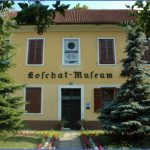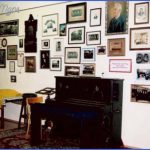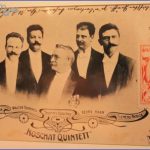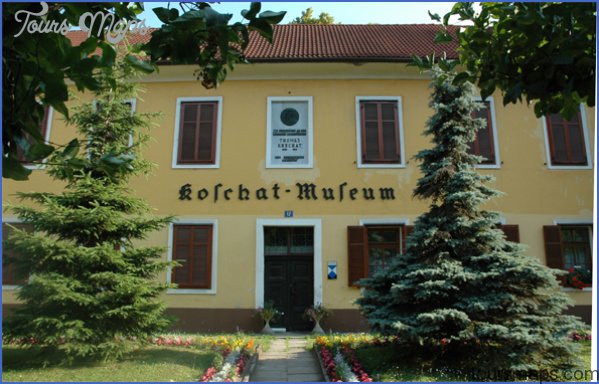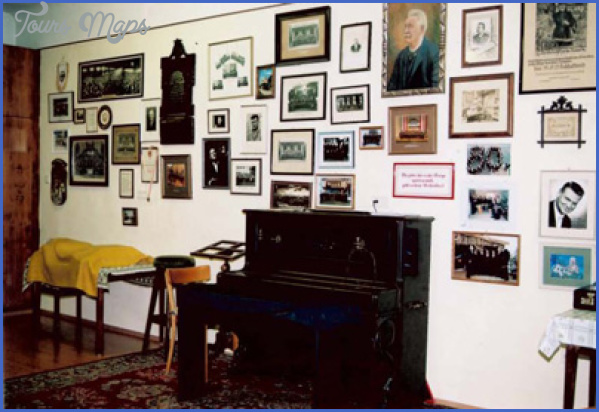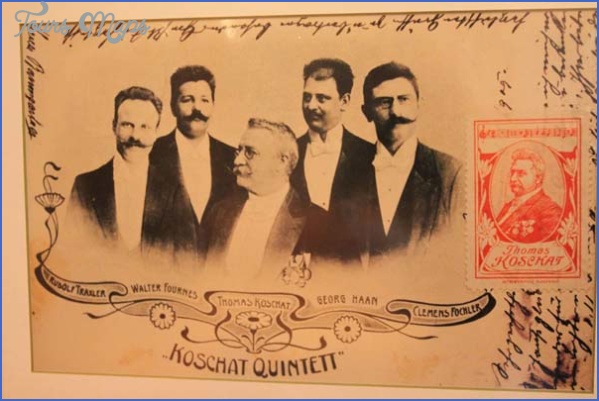KOSCHAT MUSEUM
Thomas Koschat, the Austrian bass singer who brought Carinthian folksong to a wide audience through his performances, arrangements and compositions, still has a small but dedicated following in and around Klagenfurt, on the eastern end of the Worthersee, where he was born in Viktring on 8 August 1845. The 12th-century Cistercian monastery at Viktring is now used for concerts, but the museum honouring Koschat is in the Viktringer Ring in Klagenfurt, in a building shared with the Mannerges-angverein ‘Koschatbund’, who still sing his sentimental four- and five-part settings for male voices. The society inherited Koschat’s legacy on his widow’s death in 1929 and opened the museum in
1934 – almost 20 years to the day after his death, on 19 May 1914 – and, with lottery and private donations, rebuilt it in 1951 after damage in World War II.
The society also twice erected memorials in the nearby Koschatpark: the first, a bronze bust put up in 1929, had to be melted down during the war and the second, in marble, appeared in 1952. Although Koschat lived much of his life in Vienna, and died at his home at Strobachgasse 2 in the 5th district, where there is a bronze relief memorial, he spent holidays at the Worthersee. He wrote music with local reference (for example the Viktringer Marsch ‘Das schone grune Viktring is mein Freud’ and a one-act ‘Liederspiel’ Am Worther See), became an honorary citizen of Klagenfurt in 1907 and was buried close by, at Annabichl, where there is a memorial statue. At Portschach, on the northern shore of the lake, there is another memorial. On a lighter note, at Velden, to the west, there was a Koschatkeller, just as at Klagenfurt, even in Koschat’s own day, there was a Koschatstuberl (inn) – to judge by a picture postcard he sent to his wife, Paula, now on display in the museum.
In the first room of the museum the walls are covered and the cases bursting with innumerable portraits, photographs of his family and friends (who included Bruckner, Wolf, Mahler and the poet Peter Rosegger), manuscripts and editions (his music appeared in colourful sheet-music arrangements and translated into dozens of languages), correspondence (the archive holds 4800 letters) and an astonishing collection of printed postcards of Koschatlieder which in itself attests to his popularity, as well as awards and the inevitable presentation items, many of which relate to his 50th birthday celebrations in Vienna and Klagenfurt in 1895. Much of the display focusses on the various Koschat-Quintetten in which he sang between 1877 and 1906 and the Karntnerlieder (Carinthian folksongs) he composed or set.
KOSCHAT MUSEUM Photo Gallery
The second of the first-floor museum rooms is a faithful re-creation, based on photographs by members of the
Koschatbund, of the room in which Koschat died. In addition to the bed, there is a guitar reclining on a chaise longue, a velvet armchair and bentwood rocker, and his desk, with recordings, banners, awards, a globe and an armadillo shell basket.
Hans Krasa was one of the Jewish Czech composers imprisoned in the Nazi transit camp at Terezm in 1942; he spent just over two years there and died in Auschwitz in October 1944. Born in Prague in 1899, he was a pupil of Zemlinsky and earned some success in central Europe and the USA in the late 1920s and the 30s, particularly with his opera Verlobung im Traum. His children’s opera Brundibar (‘Bumblebee’), written in 1938, was given in the Jewish orphanage in Prague in 1942 and a year later in an adaptation for the conditions at Terezm, where it had 55 performances; its production is seen as the most successful of all the cultural activities undertaken there. At Terezm, the Habsburg garrison town of Theresienstadt some 60 km north-west of Prague, built in the 1790s, Krasa was director of the music section of the group responsible for organizing leisure activities in what was presented by the Nazis as a model detention centre. Among the 140,000 people who passed through Terezm (including the 33,000 who died there), cultural activities were permitted by the authorities, at first grudgingly and from 1942 more openly, partly as a harmless outlet and partly because it became necessary for the Nazis to present the detention and transit camp as a model, especially when Red Cross visits took place or propaganda films were in prospect. There were always enough musicians among those confined there, principally Jews who had been living in Czechoslovakia, to take part in recitals, choral performances, chamber music and even orchestral and operatic performances, as well as Czech and Jewish folk music, cabaret, jazz and other lighter genres. These are recorded in the room at the Magdeburg Barracks commemorating musical activities in the camp.
The display devoted to Krasa in the music room includes manuscripts or facsimiles of several of his works composed there, including an Overture for small orchestra, Dance for string trio and a Passacaglia for Strings.
Karol Kurpinski was a leading figure in Polish music in the early 19th century, head of the royal chapel, director of music at the National Theatre in Warsaw for many years and conductor of Chopin’s earliest concerts. A prolific composer for the theatre, he has been generally regarded as the father of Polish opera since his death in 1857.
Kurpinski was born in 1785 in Wloszakowice, a village some 70 km south-west of Poznan. The house of his birth still stands and is marked by a plaque, but he is commemorated in rooms set up in 1972 on the original manor estate. The manor house itself, a splendid building set in parkland with a large hall taking the shape of an isosceles triangle (with the platform at the apex), is historically associated with the Opalinski and Leszczinski families; it is now the regional museum and administrative headquarters. Two rooms of an adjacent building, shared with an infants’ school, are devoted to Kurpinski. There are a number of display cases, with facsimiles of portraits of Kurpinski and his wife, of his music and literature relating to it, along with posters of concerts and competitions (Kurpinski was an early composer of a clarinet concerto and clarinet competitions are held regularly, in a cycle with singing and composition ones). The adjoining room features stage costumes, originally used in revivals of his operas, along with stage photographs, as well as a Pleyel piano of the period and an imaginative bust.
A plaque on the church commemorates Kurpinski’s connection, and within it the organ on which he played, dating from 1750, survives.
Maybe You Like Them Too
- Top 10 Islands You Can Buy
- Top 10 Underrated Asian Cities 2023
- Top 10 Reasons Upsizing Will Be a Huge Travel Trend
- Top 10 Scuba Diving Destinations
- World’s 10 Best Places To Visit

